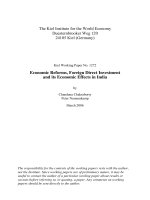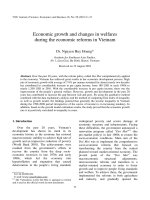- Trang chủ >>
- Khoa Học Tự Nhiên >>
- Vật lý
ugandas economic reforms insider accounts dec 2009
Bạn đang xem bản rút gọn của tài liệu. Xem và tải ngay bản đầy đủ của tài liệu tại đây (1.56 MB, 442 trang )
Uganda’s Economic Reforms
This page intentionally left blank
Uganda’s Economic
Reforms
Insider Accounts
Edited by
Florence Kuteesa, Emmanuel Tumusiime-Mutebile,
Alan Whitworth, and Tim Williamson
1
1
Great Clarendon Street, Oxford OX26DP
Oxford University Press is a department of the University of Oxford.
It furthers the University’s objective of excellence in research, scholarship,
and education by publishing worldwide in
Oxford New York
Auckland Cape Town Dar es Salaam Hong Kong Karachi
Kuala Lumpur Madrid Melbourne Mexico City Nairobi
New Delhi Shanghai Taipei Toronto
With offices in
Argentina Austria Brazil Chile Czech Republic France Greece
Guatemala Hungary Italy Japan Poland Portugal Singapore
South Korea Switzerland Thailand Turkey Ukraine Vietnam
Oxford is a registered trade mark of Oxford University Press
in the UK and in certain other countries
Published in the United States
by Oxford University Press Inc., New York
# Oxford University Press 2010
The moral rights of the authors have been asserted
Database right Oxford University Press (maker)
First published 2010
All rights reserved. No part of this publication may be reproduced,
stored in a retrieval system, or transmitted, in any form or by any means,
without the prior permission in writing of Oxford University Press,
or as expressly permitted by law, or under terms agreed with the appropriate
reprographics rights organization. Enquiries concerning reproduction
outside the scope of the above should be sent to the Rights Department,
Oxford University Press, at the address above
You must not circulate this book in any other binding or cover
and you must impose the same condition on any acquirer
British Library Cataloguing in Publication Data
Data available
Library of Congress Cataloging in Publication Data
Data available
Typeset by SPI Publisher Services, Pondicherry, India
Printed in Great Britain
on acid-free paper by Clays Ltd., St Ives Plc
ISBN 978 0 19 955623 6 (Pbk.)
978 0 19 955622 9 (Hbk.)
13579108642
Dedication
To Martha, Betty, Jamilah, Kyom, and to all our former colleagues
in the Ministry of Finance, Planning and Economic Development.
This page intentionally left blank
Preface
The fifteen years of political violence and economic mismanagement that
followed Idi Amin’s coup in 1971 left the Ugandan economy in ruins.
In 1986 peace and political stability were established in most of the country,
although North Uganda continued to experience insecurity. Between 1986/87
and 2006/07 GDP growth av eraged 6.9 per cent per annum making Uganda’s
one of the fastest growing economies in Africa. This was accompanied by a
substantial reduction in poverty levels, from 56 per cent in 1992 to 31 per cent
in 2006.
Not surprisingly, Uganda’s economic success has attracted considerable inter-
national attention. The 2005 Paris Declaration on Aid Effectiveness, the Heavily
Indebted Poor Countries (HIPC) debt relief initiative, and the growth of budget
support have all been strongly influenced by Ugandan experience and think-
ing. Ugandan innovations such as Poverty Reduction Strategies, Public Expen-
diture Tracking Surveys, Virtual Poverty Funds, and Participatory Poverty
Assessments have been widely adopted elsewhere often promoted by the
World Bank and other donors as other countries sought to emulate Uganda’s
success. Kampala has become a popular destination for study tours.
Transplanting reform measures that have worked well in one environment to
a different environment may fail (or disappoint) if critical factors underlying
their success are absent. The purpose of this book is to contribute to improved
understanding of the reforms that have underpinned Uganda’s economic suc-
cess since 1986 and to draw out key lessons, both for Uganda and for other
developing countries. The focus is on economic reforms undertaken by central
government particularly the Ministry of Finance, Planning and Economic
Development, but also the Bank of Uganda and the Ministries of Public Service
and Local Government. While political developments, policy reforms at the
sector level, and the battle against HIV and AIDS were also crucial, they are
beyond the scope of this volume.
The following chapters discuss in detail the reforms undertaken since the late
1980s across a wide range of areas of economic policy for which central govern-
ment is responsible. They are insider accounts; the authors are practitioners,
not academics. Each author was centrally involved inside the Uganda govern-
ment in implementing the reforms he or she describes; many were also
responsible for their design. While authors have attempted to be as objective as
possible, none is a totally disinterested observer. Hopefully, any shortfall in
objectivity is outweighed by authenticity.
All but two of the authors work, or have worked, for the Ministry of Finance,
Planning and Economic Development. The book is very much a team product,
which has benefited from the help of numerous colleagues in the Ministry, both
directly in the form of comments and help with data, and indirectly in the
implementation of the reforms discussed here. However, it should be stressed
that each author writes in his or her personal capacity and not on behalf of the
Uganda government.
The editors are grateful to former colleagues Tim Lamont, Mary Muduuli, and
Jamilah Whitworth for helpful comments and suggestions. They are particular-
ly grateful to James Sheppard for providing an outsider’s perspective on the text
and for strengthening its structure and format.
Finally, the book could not have been produced without financial support
from the UK Department for International Development. We are grateful to
Jonathan Beynon, Gwyneth Lee, Mercy Mayebo, and Peter Oumo of DFID
Uganda for their help and encouragement. The views or opinions in this book
of co-author Alan Whitworth are entirely his own and do not represent those of
DFID, where Alan has worked for several years.
Florence Kuteesa, Emmanuel Tumusiime-Mutebile, Alan Whitworth, and Tim
Williamson
viii
Preface
Contents
List of Figures xiv
List of Tables xv
List of Boxes xvii
List of Abbreviations xviii
Notes on Contributors xxii
1. Overview of Ugandan Economic Reform since 1986 1
Alan Whitworth and Tim Williamson
1 Introduction 1
2 The pre-reform period: 1986 to 1990 3
3 The technocratic era: 1990 to 1995 4
4 The poverty eradication period: 1995 to 2002 14
5 2002 onwards 24
6 Impact of economic reforms 27
7 Conclusions 31
2. Institutional and Political Dimensions of Economic Reform 35
Emmanuel Tumusiime-Mutebile
1 Background: the economy before 1986 35
2 Institutions inherited by the NRM government 37
3 January 1986 to mid-1987: starting out 38
4 Mid-1987 to 1992: early reforms 40
5 1992 to 1995: establishment of fiscal discipline 41
6 1995 to 2002: the poverty agenda 45
7 Attachment to planning 47
8 Impact of democracy 49
9 Uganda Commercial Bank 49
10 Conclusions: the role of President Museveni 50
3. Exchange Rate, Fiscal, and Monetary Policy 52
Charles Byaruhanga, Mark Henstridge, and Louis Kasekende
1 Introduction 52
2 The two big reforms of the early 1990s 53
3 Sustaining reform during the 1990s 57
4 The evolution of macroeconomic policy during the 2000s 71
5 Conclusions 87
4. Public Service Restructuring and Pay Reform 89
Mary Goretti Sendyona
1 Introduction 89
2 Restructuring and reorganization 89
3 Pay reform 96
4 Conclusions 101
5. Tax Reform 103
Gerry Cawley and Justin Zake
1 Introduction 103
2 Tax policy reform 104
3 Tax administration reform 114
4 Impact of the reforms 122
5 Conclusions 127
6. Planning and Development Budget Reform, 1990 –1995 129
Alan Whitworth
1 Introduction 129
2 Planning in the National Resistance Movement years 130
3 1991 review of the planning system 131
4 Reform of the planning system 135
5 Impact of the reforms 146
6 Conclusions and lessons 151
7. The Poverty Eradication Action Plan 157
Kenneth Mugambe
1 Introduction 157
2 The 1997 Poverty Eradication Action Plan 158
3 First revision of the PEAP 161
4 Second revision of the PEAP 166
5 From the PEAP to the National Development Plan 168
6 Lessons, challenges, and future prospects 169
8. Budget Reform and the Medium Term Expenditure Framework 172
Martin Brownbridge, Giulio Federico, and Florence Kuteesa
1 Introduction 172
2 Evolution of the Medium Term Expenditure Framework 173
3 The consultative budget process 175
4 Other budget reforms 176
x
Contents
5 Resource allocation and the Medium Term Expenditure
Framework 182
6 Did the MTEF facilitate a shift in sectoral allocations
of the budget? 185
7 Did the MTEF improve the predictability of the budget? 187
8 Challenges in budget reform 192
9 Conclusions 194
9. Sector Wide Approach and Sector Working Groups 208
Ishmael Magona
1 Introduction 208
2 Sector policy reform, strategic planning, and coordination 209
3 MTEF and Sector Working Groups 211
4 Supporting changes in sector financing and donor coordination 212
5 Sector reporting and review processes 215
6 The maturing of SWAps 216
7 Achievements and limitations of SWAps 220
8 Conclusions 225
10. Poverty Monitoring 226
Margaret Kakande
1 Introduction 226
2 Mainstreaming of poverty issues in budgets and programmes 226
3 Poverty Monitoring and Evaluation Strategy 229
4 Technical issues in measuring poverty 232
5 Poverty trends 236
6 Reforms and developments behind the poverty trends 243
7 Findings and conclusions 244
11. Statistics Reform 246
E. S. K. Muwanga-Zake
1 Institutional history of statistics development 246
2 Major statistical programmes 250
3 Institutional arrangements 259
4 Conclusions 263
12. Debt Management and Debt Relief 264
Damoni Kitabire
1 Introduction 264
2 The 1991 Debt Strategy 265
3 Impact of the 1991 Debt Strategy 268
4 The 1995 Enhanced Debt Strategy 268
5 HIPC Debt Relief Initiative 271
xi
Contents
6 Multilateral Debt Relief Initiative 273
7 Poverty Action Fund 275
8 Conclusions 276
13. Aligning Aid with Government Fiscal Objectives 277
Martin Brownbridge
1 Introduction 277
2 A note on aid data 278
3 Aid flows to Uganda 281
4 The shift towards budget support 286
5 Integrating donor-funded projects into the MTEF 294
6 Aligning donor aid with the government’s macroeconomic
objectives 297
7 Conclusions and lessons 307
14. Fiscal Decentralization 310
Tim Williamson
1 Introduction 310
2 Evolution of local government 311
3 Financing of local government 315
4 Planning, budgeting, and financial management in local
government 323
5 The balance sheet of decentralization 334
6 Conclusion 336
15. Financial Management and Accountability Reform 338
Gustavio Bwoch and Robert Muwanga
1 Introduction 338
2 Pressures to improve financial management and accountability
during the 1990s 339
3 Challenges faced by financial management and accountability
systems in the 1990s 341
4 Reforms to the policy framework for public financial
management 343
5 Automation of financial management systems 347
6 Overall impact of PFM reforms 352
7 Conclusions 353
16. Privatization and Parastatal Reform 355
Emmanuel Nyirinkindi and Michael Opagi
1 Introduction 355
2 Parastatal policy from 1987 357
3 Legal framework 360
xii
Contents
4 Implementation 362
5 Divestiture proceeds 367
6 Impact of the divestiture programme 369
7 Conclusions 373
Bibliography 383
Index 397
xiii
Contents
List of Figures
1.1 Uganda Per Capita Real GDP (1990 100) 2
1.2 Per Capita Real GDP Growth (%) 28
3.1 Actual and Counterfactual Government Budgetary Operations,
1994/95 1995/96 63
3.2 Short Term Fiscal Response to Increased Inflation, 1992/93 1997/98 65
3.3 UGX/USD Exchange Rates 67
3.4 Drivers of Monetary Conditions 73
8.1 Public Expenditure under the MTEF, 1994/95 2004/05, constant prices 185
8.2 Sectoral Composition of the MTEF, 1994/95 2004/05
(Annual Outturns, Budget Releases) 186
9.1 Planning, Budgeting, Reporting, and Review Processes in the Early 2000s 217
9.2 Primary Health Care and Education Services (Millions of Pupils/Visits) 220
9.3 Rural Safe Water Coverage (% of Rural Population Served) 221
10.1 Trends in Income Poverty 238
10.2 Trends in Infant and Under 5 Child Mortality Rates, 1989 2006 241
13.1 Trends in the Fiscal Deficit Before Grants and the Government Budget
Deficit Before Grants (% of GDP), 1991/92 2005/06 299
13.2 Private Sector Credit and Bank Holdings of Government Securities
(% of Commercial Banks’ Deposits, and Private Sector Credit as % of GDP),
June 1995 June 2006 302
16.1 Number of Divestitures by Year 367
16.2 Parastatal Sector Subsidies (Direct and Indirect), 1995 2004 371
List of Tables
1.1 Selected Fiscal Indicators (% GDP), 1991/92 2006/07 29
3.1 Before and After Stability 57
3.2 Information Lags, Cashflow Compilation, and Short Term
Macroeconomic Management 60
3.3 Actual Budget and Cashflow Outturn, 1991/92 1996/97 61
3.4 Macroeconomic Indicators, 1997/98 2007/08 72
3.5 Quarterly Cash Spending Limits and Outturn, 2004/05 2006/07 78
3.6 Actual Budget and Cashflow Outturn, 1997/08 2006/07 81
4.1 Monthly Salaries for Various Grades in 1991 and 2005 90
4.2 Retrenchment and Voluntary Retirement Costs of Severance
Packages, 1992 2005 93
4.3 Public Service Numbers and Wage Bill, 1990 2005 96
4.4 Number of Public Servants by Grade in Selected Years 97
5.1 Average Tax Revenue in Selected Sub Saharan African Countries (as % GDP),
1985 1996 104
5.2 URA Collections (as % GDP), 1991/92 2006/07 111
5.3 Uganda, Selected Trade Data, 1991 2004 125
6.1 Development Budget Approved Estimates and Actual Expenditure
(USD million), 1990/91 1995/96 147
8.1 Projections and Outturns of the Budget Resource Envelope and its
Components, 1999/2000 2004/05 188
9.1 Domestic Budget Allocations to Sector PEAP Priorities, 1997/98 2006/07 214
9.2 Quality of Ser vice Delivery in Health and Education Sectors 221
10.1 Poverty Trends by Region and Sector of Household Head 239
12.1 Uganda’s Debt Service, 1995/96 2006/07 (pre and post debt relief) 274
13.1 Fiscal Aggregates (% GDP), 1991/92 2006/07 282
13.2 Aid to the Central Government Budget (in USD million and % GDP),
1991/92 2006/07 283
13.3 Breakdown of Budget Support Disbursements (in USD million),
2000/01 2005/06 285
13.4 Fiscal Liquidity Creation, Sterilization Operations, and Net Domestic
Financing (in UGX billion), 1997/98 2005/06 301
13.5 Actual Versus Projected Disbursements of Budget Support (in USD million),
1999/00 2003/04 304
14.1 Grants to Local Governments, 1995/96 2007/08 316
14.2 Declining Locally Raised Revenues 321
14.3 Total Local Government Revenues and the Degree of Flexibility 323
14.4 Typical Local Government Revenue and Expenditure in 2005 324
16.1 Cumulative Divestiture Proceeds to June 2006: Sources and Uses 368
xvi
List of Tables
List of Boxes
1.1 Liberalization of Coffee Marketing 6
1.2 Public Service Reform 10
1.3 Project Planning System 12
2.1 Salary Supplements or ‘Incentives’ 43
2.2 Building Economic Management Capacity 44
3.1 The Cashflow 59
6.1 Aid Database 142
6.2 Public Expenditure Tracking Surveys 143
7.1 The Main Features of the 1997 PEAP 160
7.2 The Main Elements of the 2000 PEAP 163
7.3 The 2000 PEAP Partnership Principles 164
7.4 The Main Elements of the 2004 PEAP 167
9.1 Early Reforms in the Education Sector 210
9.2 Education Funding Agencies Group 215
9.3 Extracts from the Partnership Principles Relating to Sectors 219
9.4 Role of MoFPED Sector Desk Officers 222
10.1 Participatory Poverty Assessment 231
14.1 A Short History of Decentralization in Uganda 311
14.2 Structure and Mandates of Local Government 313
14.3 Local Revenue Sources 320
14.4 Effects of Decentralization and Increased Transparency on Leakage of Funds 325
14.5 PAF General Guidelines for Conditional Grants 327
14.6 Local Government Assessment and the Local Development Grant 328
14.7 Overview of the Fiscal Decentralization Strategy 331
15.1 Provisions for PFM in the 1995 Constitution 344
15.2 Public Finance and Accountability Act (2003) 345
16.1 Generic Steps in Typical Privatization Transactions 362
16.2 Return of Departed Asian Properties 363
16.3 Broadening Participation and Transparency 366
List of Abbreviations
ADF African Development Fund
APIR Annual PEAP Implementation Review
APPERD Action Plan for Public Enterprise Reform and Divestiture
ASYCUDA Automated System for Customs Data
ASU Anti Smuggling Unit
BFP Budget Framework Paper
BoP Balance of Payments
BoU Bank of Uganda
CDF Comprehensive Development Framework
CMB Coffee Marketing Board
COMESA Common Market for Eastern and Southern Africa
CPI Consumer Price Index
CSO Civil Society Organisation
CST Coffee Stabilization Tax
CTL Commercial Transactions Levy
DAC Development Assistance Committee
DFID Department for International Development (UK)
DHS Demographic and Health Survey
DRIC Divestiture and Reform Implementation Committee
EAC East African Community
EACSO East African Common Services Organisation
EASD East African Statistical Department
EFAG Education Funding Agencies Group
FDS Fiscal Decentralization Strategy
GBS General Budget Support
GoU Government of Uganda
GDP Gross Domestic Product
HBS Household Budget Survey
HIPC Heavily Indebted Poor Country
HIV/AIDS Human Immunodeficiency Virus/Acquired
Immunodeficiency Syndrome
IDA International Development Association (World Bank)
IFMS Integrated Financial Management System
IMF International Monetary Fund
IPO Initial Public Offering
LG Local Government
LGBFP Local Government Budget Framework Paper
LGDP Local Government Development Programme
LGFC Local Government Finance Commission
LTD Large Taxpayer Department
MDA Ministries, Departments, and Agencies
MDF Multilateral Debt Fund
MDG Millennium Development Goal
MDRI Multilateral Debt Relief Initiative
M&E Monitoring and Evaluation
MIGA Multilateral Investment Guarantee Agency
MoES Ministry of Education and Sports
MoF Ministry of Finance (until 1992 and 1996 1998)
MoFEP Ministry of Finance and Economic Planning (1992 1996)
MoFPED Ministry of Finance, Planning and Economic Development (since 1998)
MoPED Ministry of Planning and Economic Development (until 1992 and
1996 1998)
MoLG Ministry of Local Government
MoPS Ministry of Public Service
MTEF Medium Term Expenditure Framework
NDF Net Domestic Financing
NDP National Development Plan
NGO Non Government Organization
NIMES National Integrated Monitoring and Evaluation Strategy
NPA National Planning Authority
NPV Net Present Value
NRA National Resistance Army
NRM National Resistance Movement
NTE Non Traditional Exports
NWSC National Water and Sewerage Corporation
ODI Overseas Development Institute
List of Abbreviations
xix
OECD Organisation for Economic Cooperation and Development
OPM Office of the Prime Minister
PAF Poverty Action Fund
PE Public Enterprise
PEAP Poverty Eradication Action Plan
PEC Presidential Economic Council
PER Public Expenditure Review
PERD Public Enterprise Reform and Divestiture
PETS Public Expenditure Tracking Survey
PEWG Poverty Eradication Working Group
PFM Public Financial Management
PIP Public Investment Plan
PIU Project Implementation Unit
PMAU Poverty Monitoring and Analysis Unit
PMES Poverty Monitoring and Evaluation Strategy
PMU Parastatal Monitoring Unit
PPA Participatory Poverty Assessment
PPG Public and Publicly Guaranteed (Debt)
PRGF Poverty Reduction and Growth Facility (IMF)
PRSC Poverty Reduction Support Credit (World Bank)
PRSP Poverty Reduction Strategy Paper
PSRRC Public Service Review and Re organisation Commission
RDP Rehabilitation and Development Plan
REER Real Effective Exchange Rate
RSDP Road Sector Development Plan
SDA Social Dimensions of Adjustment
SRPS Special Revenue Police Service
SWAp Sector Wide Approach
SWG Sector Working Group
TA Technical Assistance
TIN Taxpayer Identification Number
ToT Terms of Trade
UBI Uganda Business Inquiry
UBoS Uganda Bureau of Statistics
UCB Uganda Commercial Bank
UCF Uganda Consolidated Fund
UCS Uganda Computer Services
xx
List of Abbreviations
UDC Uganda Development Corporation
UEB Uganda Electricity Board
UEDC Uganda Electricity Distribution Company Ltd
UEGC Uganda Electricity Generation Company Ltd
UETC Uganda Electricity Transmission Company Ltd
UGX Uganda Shilling
UIA Uganda Investment Authority
UMA Uganda Manufacturers’ Association
UNDP United Nations Development Programme
UNHS Uganda National Household Surveys
UPE Universal Primary Education
URA Uganda Revenue Authority
URC Uganda Railways Corporation
USD United States Dollar
USE Uganda Stock Exchange
UTL Uganda Telecom Ltd
VAT Value Added Tax
WTO World Trade Organization
xxi
List of Abbreviations
Notes on Contributors
Martin Brownbridge is a consultant on macroeconomics and fiscal policy.
From 1998 to 2004 he was Macroeconomic Advisor in the Ugandan Ministry of
Finance, Planning and Economic Development. He has also worked as macro-
economic advisor to the Ministry of Finance in The Gambia, as a long-term
consultant in Ghana and Tajikistan, and as macro-fiscal advisor for the East Africa
Regional Technical Assistance Centre of the International Monetary Fund.
Gustavio Bwoch has been the Accountant General of Uganda since 2003. He
joined the Ministry of Finance, Planning and Economic Development as Com-
missioner, Treasury Office of Accounts in 1998 and served as Director of Ac-
counts in 2002. He previously worked as Deputy Financial Manager with the
Water and Sewerage Authority of Lesotho and as a Financial Accountant with
Transocean (Uganda) Ltd.
Charles Byaruhanga is the Budget Advisor in the Ugandan Ministry of Finance,
Planning and Economic Development. Between 1992 and 1999 he worked as a
senior economist in the Economic Analysis Unit and the Macroeconomic
Policy Department of the Ministry, and served as Commissioner for Macroeco-
nomic Policy. In 1999 he left to undertake public sector consulting assignments
for a number of development agencies, including the World Bank, before
returning to the Ministry in 2005.
Gerry Cawley is an independent economic consultant based in Nairobi, Kenya.
From 1994 to 2000 he was Tax Policy Adviser in the Ugandan Ministry of
Finance, Planning and Economic Development, Kampala. He worked for twelve
years as an economist in Ireland’s Department of Finance and for fourteen years
as an economist/tax adviser for the governments of Lesotho and Botswana.
Giulio Federico is a Senior Consultant at CRA International and a Research
Fellow at IESE Business School in Barcelona. From 2001 to 2003 he worked as a
Senior Economist in the Budget Policy Department of the Ugandan Ministry of
Finance, Planning and Economic Development, with responsibility for the
management and execution of the Medium Term Expenditure Framework.
Mark Henstridge is Director, Group Economics at BP, London. From 1988 to
1990 he was an Economist in the Ugandan Ministry of Planning and Economic
Development, as an ODI Fellow. From 1994 to 1996 he was the Advisor on
Macroeconomic Policy in the Ministry of Finance and Economic Planning.
From 1997 to 2001 he was an Economist at the International Monetary Fund,
Washington, DC.
Margaret Kakande is Head of the Budget Monitoring and Accountability Unit
in the Ugandan Ministry of Finance, Planning and Economic Development,
and chair of the Advisory Group to the International Chronic Poverty Centre,
Manchester University. From 1996 to 2008 she was the Poverty Analyst and
Head of the Poverty Monitoring and Analysis Unit that led the formulation of
the first Poverty Eradication Action Plan and the Participatory Poverty Assess-
ments. Prior to joining government she lectured in statistics at Makerere
University.
Louis Kasekende is Chief Economist of the African Development Bank. Prior to
joining the Bank, he worked for seventeen years in the Bank of Uganda in
several capacities, including as Deputy Governor, Executive Director for Re-
search and Policy, and Director of the Research Department. From 2002 to
2004 he was Executive Director, representing twenty-two African countries,
on the Executive Board of the World Bank. He has also lectured in economics
at Makerere University.
Damoni Kitabire is a Lead Economist in the Fragile States Unit of the African
Development Bank. He held several senior positions in the Ugandan Ministry
of Finance, Planning and Economic Development, including Commissioner
Macroeconomic Policy (1993 97), Director Budget (1997 98), Director Economic
Affairs (1998 99), and Macroeconomic Advisor (2004 07). From 1999 to 2003 he
was a Senior Economist in the Policy Development and Review Department of the
International Monetary Fund, Washington, DC.
Florence Kuteesa is an Independent Public Expenditure Management Consul-
tant based in Kampala. From 1983 to 2004, she woked for the Ugandan Minis-
try of Finance, Planning and Economic Development, rising from the level of
Economist to Budget Director. She was a Senior Manager in Pricewaterhouse-
Coopers, Nairobi, from 2005 to 2006. Between 2007 and 2009 she was a Public
Expenditure Management Advisor in the East Africa Regional Technical Assis-
tance Centre of the International Monetary Fund, Dar es Salaam.
Ishmael Magona has been the Commissioner for Infrastructure and Social
Services in the Ugandan Ministry of Finance, Planning and Economic Develop-
ment since 2005. His government career began in 1988 as an Economist in the
Manpower Planning Department of the Ministry of Planning and Economic
Development. He was Commissioner, Budget Policy and Evaluation, between
2003 and 2005.
Notes on Contributors
xxiii
Kenneth Mugambe has been the Commissioner, Budget Policy and Evaluation,
in the Ugandan Ministry of Finance, Planning and Economic Development
since 2005. He started as an Economist in the Ministry of Planning and Eco-
nomic Development in 1992. From 1999 to 2004 he was Assistant Commis-
sioner, Economic Development Policy and Research, where he was a leader of
the team that formulated the Poverty Eradication Action Plan 2004.
Robert Muwanga is a Public Expenditure Management Advisor with the United
Nations Development Programme in Sudan. Prior to this he was project coordi-
nator for the Financial Accountability Programme (2006 07) and the Economic
and Financial Management Project (1999 2006) in the Ugandan Ministry of
Finance, Planning and Economic Development, Kampala. Between 1988 and
1998 he worked as a systems analyst/programmer, supporting the budget and
accounting system in the same Ministry.
E. S. K. Muwanga-Zake is the Chairman of the Board of Directors of the Uganda
Bureau of Statistics. Between 1994 and 1998 he was the Commissioner for
Statistics, Statistics Department, Ministry of Finance and Economic Planning.
He led the process of converting the Statistics Department into the Bureau of
Statistics. He taught statistics at the Institute of Statistics and Applied Econom-
ics, Makerere University between 1978 and 1988. He has also worked at the
Bank of Uganda for ten years.
Emmanuel Nyirinkindi is the Manager for Africa Region in the Infrastructure
Advisory Department of the International Finance Corporation, Johannesburg.
From 1989 to 2006 he worked in various positions with the privatization and
parastatal reform programme including as a Director from 1996 of the Ugan-
dan Ministry of Finance, Planning and Economic Development. Prior to join-
ing the Ministry, he worked for Esso Standard (Uganda) Ltd and as a Graduate
Research Fellow in the Faculty of Commerce at Makerere University.
Michael Opagi is a Senior Investment Officer with the International Finance
Corporation in Johannesburg. From 1989 to 2007 he worked in various posi-
tions with the privatization and parastatal reform programme including as
the Director of the Privatization Unit from 1996 of the Ugandan Ministry of
Finance, Planning and Economic Development. He also worked as a privatiza-
tion expert on short term contracts to the World Bank in Ethiopia and Zambia.
He has served on several boards of directors.
Mary Goretti Sendyona is an Assistant Commissioner in the Ugandan Ministry
of Public Service. Since 1992 she has been involved in implementing the Public
Service Reform Programme, working on pay reform, wage bill management,
payroll management, retrenchment, and voluntary retirement.
Emmanuel Tumusiime-Mutebile has been Governor of the Bank of Uganda
since January 2001. His previous appointments include: Permanent Secretary/
Notes on Contributors
xxiv









